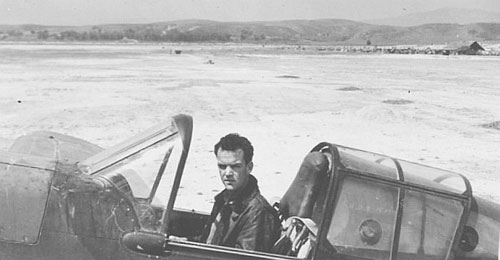William McGarry, a member of the storied Flying Tigers who escaped after three years as a Japanese prisoner of war during World War II, has died. He was 74.
McGarry died Friday of cancer at the Veterans Hospital in Loma Linda, his brother, Bernard McGarry, said Wednesday.
Nicknamed “Happy-Go-Lucky” for his ebullient personality, McGarry learned to fly in the U.S. Army Air Forces at Selfridge Field, Mich. In 1941, several months before the United States entered the war, McGarry volunteered to fly with Gen. Claire Chennault’s American Volunteer Group, the Flying Tigers, aiding Burma and China against the Japanese.
Already recognized for his artistic talents as a student at Loyola University, McGarry was credited with designing the “Adam and Eve” serpent-wrapped apple insignia on the P-40 fighter planes of Chennault’s 1st Pursuit Squadron.
On March 24, 1942, flying over Thailand, McGarry’s Tomahawk was hit by Japanese machine-gun fire and he bailed out, parachuting into a clearing. It was late October before his family in Los Angeles learned that he was alive and imprisoned by the Japanese in Bangkok. His family said the Chinese government had continued to pay his salary and had deposited $6,000 for the 12 Japanese planes McGarry shot down before his capture.
McGarry was held for nearly three years, his brother said, before escaping with the help of the Thai (then Siamese) government and the Office of Strategic Services, forerunner of the Central Intelligence Agency.
He was smuggled out of Bangkok in a coffin by Thais who claimed that he had died in captivity, said a friend from flight-training days, Hector Gonzalez. The escape was the subject of a major article in Collier’s magazine.
McGarry rapidly completed Loyola Law School after the war and practiced law with U.S. military services and then privately in Los Angeles. He retired and moved to Desert Hot Springs in 1980.
Source: Obituary LA Times April 6, 1990.

PRIVATE CITIZENS SUPPORTING AMERICA'S HERITAGE
American
War Memorials Overseas, Inc.
War Memorials Overseas, Inc.
McGarry William “Happy-Go-Lucky”
Name:
William “Happy-Go-Lucky” McGarry
Rank:
Captain
Serial Number:
Unit:
1st American Volunteer Group (Flying Tigers)
Date of Death:
1990-04-05
State:
California
Cemetery:
Plot:
Row:
Grave:
Decoration:
Comments:
